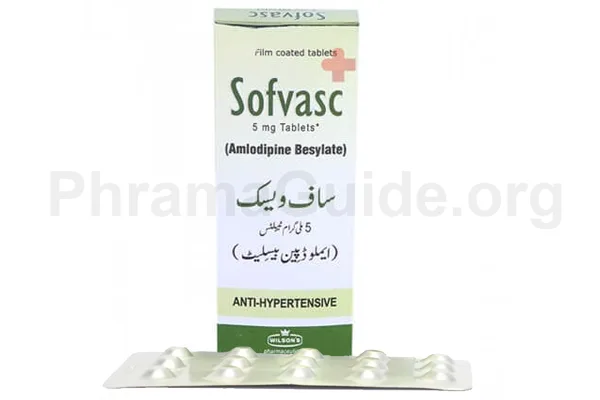Sofvasc is a calcium channel blocker commonly prescribed to treat high blood pressure (hypertension) and certain types of chest pain (angina). While many people tolerate Sofvasc well, some individuals may experience side effects. Here are some common and less common side effects of Sofvasc.
Common Side Effects
- Peripheral Edema: Swelling in the ankles, feet, or legs is a relatively common side effect of Sofvasc. This occurs due to the dilation of blood vessels, allowing fluid to accumulate in the tissues.
- Flushing or Warmth: Some individuals may experience a sensation of warmth or flushing, particularly in the face.
- Dizziness: Sofvasc can cause a drop in blood pressure, leading to dizziness or lightheadedness, especially when standing up quickly.
- Palpitations: Some people may notice a rapid or irregular heartbeat.
- Fatigue: Feeling tired or fatigued is a common side effect of Sofvasc.
- Headache: Sofvasc may cause headaches in some individuals.
- Nausea or Abdominal Pain: Gastrointestinal symptoms such as nausea or abdominal discomfort can occur.
Less Common Side Effects
- Hypotension (Low Blood Pressure): In some individuals, Sofvasc may cause a more pronounced drop in blood pressure, leading to symptoms such as dizziness, fainting, or lightheadedness.
- Irregular Heartbeat (Arrhythmia): Sofvasc can affect the electrical conduction in the heart, leading to irregular heartbeats in some cases.
- Gingival Hyperplasia: This refers to an overgrowth of the gums, a less common side effect seen with some calcium channel blockers, including Sofvasc.
- Muscle Cramps or Weakness: Some individuals may experience muscle-related symptoms, such as cramps or weakness.
- Increased Frequency of Urination: Sofvasc may lead to increased urine production in some individuals.
- Allergic Reactions: While rare, some people may experience allergic reactions to Sofvasc, such as skin rash, itching, or swelling.
- Jaundice (Yellowing of the Skin or Eyes): In rare cases, Sofvasc may affect liver function, leading to jaundice.
- Changes in Mood or Mental Status: Some individuals may experience mood swings, anxiety, or changes in mental alertness.
- Peripheral Neuropathy: There have been rare reports of Sofvasc being associated with peripheral neuropathy, which can cause tingling, numbness, or pain in the extremities.

What is Sofvasc?
Sofvasc is one of the leading brands of Amlodipine, manufactured and marketed by Wilsons Pharmaceuticals, Pakistan.
Sofvasc : Available Formulations and Strengths
Presently, Sofvasc is available in Tablets Form.
Sofvasc Tablets : 2.5mg, 5mg, and 10mg strengths.
What Are The Possible Drug Interactions of Sofvasc?
- CYP3A4 Inhibitors: Sofvasc is primarily metabolized by the CYP3A4 enzyme in the liver. Drugs that inhibit CYP3A4 may increase the levels of Sofvasc in the blood, potentially leading to an increased risk of side effects. Examples of CYP3A4 inhibitors include ketoconazole, itraconazole, clarithromycin, and grapefruit juice.
- CYP3A4 Inducers: Drugs that induce CYP3A4 may decrease the levels of Sofvasc in the blood, potentially reducing its effectiveness. Examples of CYP3A4 inducers include rifampin, phenytoin, and St. John’s wort.
- Beta-Blockers: Combining Sofvasc with beta-blockers, such as metoprolol or propranolol, may lead to an additive antihypertensive effect, lowering blood pressure further. However, caution is needed to prevent excessive blood pressure reduction.
- ACE Inhibitors and Angiotensin II Receptor Blockers (ARBs): Concurrent use of Sofvasc with ACE inhibitors (e.g., lisinopril) or ARBs (e.g., losartan) can enhance the antihypertensive effects. This combination is often used in some patients with hypertension.
- Diuretics: Thiazide diuretics, loop diuretics, or potassium-sparing diuretics, when taken with Sofvasc, may enhance the blood pressure-lowering effects and increase the risk of electrolyte imbalances.
- Sildenafil (Viagra) and Tadalafil (Cialis): Phosphodiesterase-5 (PDE-5) inhibitors used for erectile dysfunction, such as sildenafil and tadalafil, may enhance the blood pressure-lowering effects of Sofvasc, leading to symptomatic hypotension.
- Lithium: Sofvasc may increase lithium levels in the blood, potentially leading to lithium toxicity.
- Simvastatin: Combining Sofvasc with simvastatin, a statin used to lower cholesterol, may increase the risk of muscle-related side effects.

Leave A Comment